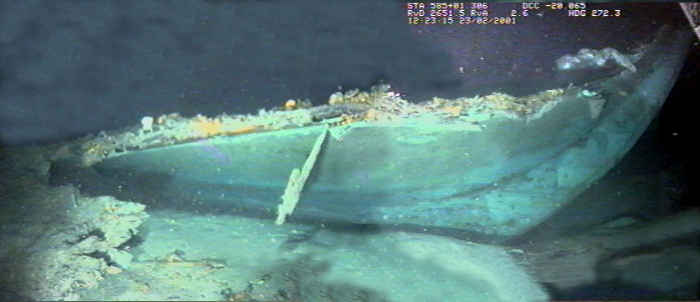
The Mica Wreck was discovered in 2001 during a post-construction pipeline survey for ExxonMobil Development Company. The shipwreck was not identified as a possible archaeological site during the initial remote sensing survey for the proposed pipeline route. Once the wreck was discovered during the ROV pipeline inspection, it was determined that the pipeline had been laid across the wreck and bisected the hull through its midsection. ExxonMobil notified BOEM (then MMS) of the recently discovered shipwreck and sponsored an ROV investigation later in 2001 to learn more about the site. Lying in more than 2,500 feet of water in the Mississippi Canyon leasing area, the Mica Wreck measures approximately 65 ft. (19 m) in length with a nearly 20 ft. (6 m) beam. The wooden hull is sheathed in copper and is mostly intact, except for the port and starboard sides near amidships, which splay outward due to the weight of the pipeline. This 2001 investigation collected fragments of wood, small samples of copper sheathing, and a lead hawse-pipe. Wood samples were identified as Northern White Pine, a species of wood native to the Northeastern and upper Mid-Atlantic area of the United States. Based on this investigation and cursory data collection, MMS determined that the best course of action would be to leave the pipeline in place and conduct a more detailed data recovery project.
A 2001 AUV survey conducted by C&C Technologies was performed to determine if any other wreckage or debris associated with the wreck lie in areas adjacent to the main site. Side scan sonar imagery indicated that the surrounding seafloor was largely devoid of shipwreck debris and that the site was relatively contained. In 2002 and 2003, MMS sponsored a study by Texas A&M University to perform more detailed mapping and recording of the site and its features. Funding was provided by the operator under the Archaeological and Historic Preservation Act of 1974, as amended (16 U.S.C. 469-469c-2), otherwise known as the Moss-Bennett Act. This act allows government agencies to collect fees from a private source to a fund a salvage archaeology project. Using the U.S. Navy’s Nuclear Research Submarine, NR-1, and the SSV Carolyn Chouest during the 2002 project, archaeologists collected additional imagery to compile a photomosaic of the site and recovered a limited number of artifacts and samples. A subsequent cruise in 2003, supported in part by Deep Marine Technology, completed the fieldwork and data collection tasks. Analysis of the data indicated that the wreck was a two-masted sailing ship – possibly a schooner – that may have been built in the early part of the 19th century in the Northeastern U.S. Charred sections of planks indicated that the vessel may have caught fire before she sank. Very few diagnostic artifacts were observed within the hull. A white ceramic fragment decorated with a green line offered nothing more than a tantalizing clue to the Mica Wreck’s age, identity, and function. The Mica Wreck has not been revisited by archaeologists since 2003.